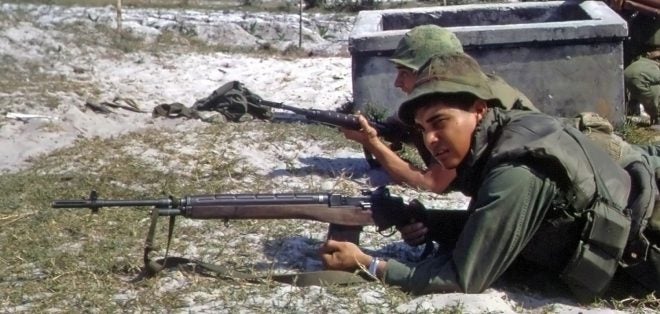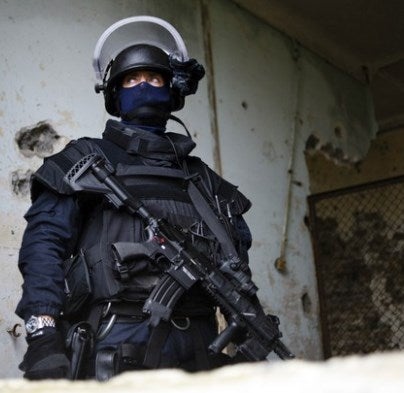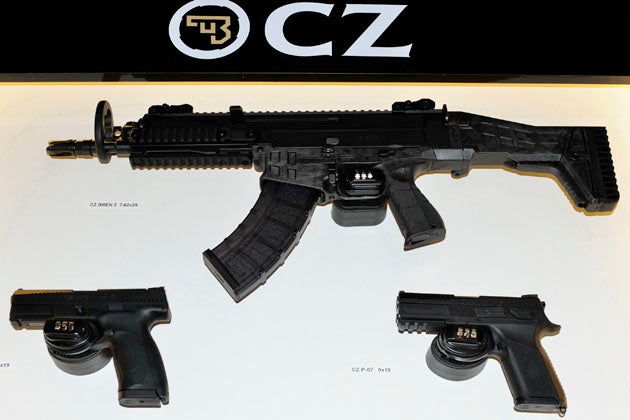Install the app
How to install the app on iOS
Follow along with the video below to see how to install our site as a web app on your home screen.
Note: This feature may not be available in some browsers.
You are using an out of date browser. It may not display this or other websites correctly.
You should upgrade or use an alternative browser.
You should upgrade or use an alternative browser.
5.56 vs 7.62
- Viestiketjun aloittaja Second
- Aloitus PVM
miheikki
Greatest Leader
http://www.thefirearmblog.com/blog/...oing-back-1954-interim-7-62mm-infantry-rifle/
BREAKING: US Army Considering Going Back to 1954 with Interim 7.62mm Infantry Rifle
Posted 21 hours ago in Breaking News, Daily News, Guns & Gear, News, Other Gear & Gadgets, Rifles by Nathaniel F with 330 Comments
Tags: .264, .30 cal, 5.56mm, 6.5mm, 7.62mm, Afghanistan, back to the future, d'oh, derp, HK417, m110, m110a1, m14, maybe it's a late april fools, mk 17, mk17, overmatch, SCAR, SCAR-H, SR-25, US Army, you never go full retard

According to a recent article on Soldier Systems, the US Army is considering an “interim” switch back to the 7.62mm caliber in standard infantry rifles. Eric Graves of the site lays out a reasonable overview of the situation on the ground, and what sort of weapons might be considered as the 7.62mm “interim” weapon. Follow the link to read his article over at soldiersystems.net.
I don’t usually editorialize on news articles like this, but I’d like to take a moment to list all the reasons switching back to an all-7.62mm fleet would be a very, very poor thing for the Army to do:
In short, a switch to the 7.62mm NATO amounts to trading one relatively minor problem – that of confronting medium machine guns with small units like the fireteam or squad – for a major one. The reality of achieving fire superiority at short range with lightweight ammunition from rapid fire guns is one that is so important that it shaped the landscape of 20th Century small arms design ever since the end of World War II.
- Unit endurance would be cut in half. The infantry platoon would go from carrying 16,700 rounds of ammunition to carrying 9,400 rounds, a decrease of almost 44%. This means units would run out of ammunition in a little over half the time that they would with the current ammunition configuration.
- Soldier training would take much longer to reach similar proficiency levels, and more regular training would be necessary to maintain it. 7.62x51mm produces substantially more recoil than 5.56mm, even in heavier weapons, and it takes more skill to master weapons in this caliber. While this may not be a problem for the civilian deer hunter or recreational shooter, is a problem for a fighting force which must train thousands of recruits of different backgrounds and natural skill levels to proficiency, especially when the whole point of moving to 7.62mm would be to give more lethality at long range, where shots are even harder.
- Battlefield communication would suffer. One of the most significant observations that came from TFB’s recent live fire exercise with WWII-era weaponry, conducted by Miles V, was that .30 caliber weapons produce a much larger volume of noise per shot, which greatly increases the difficulty of hearing commands given by officers and squad leaders.
- US Army units would lose their fire superiority at short range. One of the major infantry combat lessons of World War II, Korea, and Vietnam was that he who shoots the most tends to win, or at least makes it very, very hard on the other guy. The larger 7.62mm caliber brings with it a serious disadvantage in this area, which is why it and other similar calibers have been virtually universally dropped as standard rifle rounds in military forces all over the world.
The problem with this even as an “interim” solution is that so many “interim” systems went on to become permanent ones. Before .30 cal fans object to this point, they might consider that the US Army’s longest serving rifle, the M16/M4 family, was originally adopted as an “interim” design before the ambitious SPIW program bore fruit… Which it never did.
It’s a simple reality that the range disadvantage that current 5.56mm shoulder arms have versus tripod-mounted 7.62mm machine guns is not one that will lose the US Army any battles – let alone wars – anytime soon. A change in armaments can certainly wait until something better comes along.
The reality of achieving fire superiority at short range with lightweight ammunition from rapid fire guns is one that is so important that it shaped the landscape of 20th Century small arms design ever since the end of World War II.
Tässä ilmeisesti USA;n doktriini "ampua sarjatulta niin perkeleesti ettei vihollinen mahdu sekaan" eroaa Suomen armeijan doktriinista "vain tähdättyjä laukauksia kertatuella"?
Tässä ilmeisesti USA;n doktriini "ampua sarjatulta niin perkeleesti ettei vihollinen mahdu sekaan" eroaa Suomen armeijan doktriinista "vain tähdättyjä laukauksia kertatuella"?
Tuliylivoimalla lamauttaminen.
Paitsi, ettei Suomen oloissa kukaan pysty kantamaan moiseen toimivaa määrää ammuksia ihan repussa.
Tuliylivoimalla lamauttaminen.
Paitsi, ettei Suomen oloissa kukaan pysty kantamaan moiseen toimivaa määrää ammuksia ihan repussa.
Mutta jotakin tuon suuntaista lienee ollut suunnitelmissa, kun toinen kk lisättiin ryhmään. Tarkoittanee sitä, että vihollinen on tuhottava joko rynnäköllä tai tykistöllä ennen kuin ammukset loppuu.
miheikki
Greatest Leader
7.62 lyhentää teron ikää nopeammin.
GIGN Adopts CZ 806 Bren 2 in 7.62×39
Posted 10 hours ago in AK-47 / AK-74 / Everything AK, Companies, Daily News, Defense, NFA / Suppressors / Class III, Other Gear & Gadgets, Rifles by Miles V with 99 Comments
Tags: 7.62x39mm, Bataclan attack, CZ, gign, history, military, misc, News, paris, rifle, rifles
http://www.thefirearmblog.com/blog/2017/04/11/gign-adopts-cz-806-bren-2-7-62x39/

A French National Gendarmerie Intervention Group (GIGN) member participates in a training exercice at the headquarters on January 10, 2010 in Versailles Satory, west of Paris. AFP PHOTO / FRED DUFOUR (Photo credit should read FRED DUFOUR/AFP/Getty Images)
French Counter-Terrorism group National Gendarmerie Intervention Group (GIGN) recently announced at SOFINS 2017 that it would be adopting CZ’s 806 Bren 2 in 7.62x39mm with a 9 inch barrel. So far 68 carbines have been ordered for the roughly 400 man counter-terrorist force, resulting from extensive testing of various platforms in 7.62x39mm since 2015. CZ was apparently a late comer to the testing and evaluation but appears to have come out on top amongst the others involved. Currently, GIGN is stipulating that the carbine must be modified to accept a suppressor and an accompanying gas system to assist with shooting subsonic ammunition reliably. In addition to the carbine CZ is also trying to push the P-10 for adoption as well, but this appears to be a no go at present.
From Shepard Media-
It has selected the Bren 2 assault rifle from Czech company CZ. The company told Shephard at the SOFINS exhibition that the GIGN has selected the 7.62 x 39 mm version of the rifle and placed an initial order for 68 units earlier in 2017.
Additional procurements are slated to take place in the near future with the aim of replacing the majority of the H&K 416s currently in service.
The decision to adopt the Bren 2 was the result of a process that began in 2015 after the Paris attacks in January that year. Faced with terrorists equipped with bullet-proof vests, French gendarmerie and police intervention units found that 9 mm weapons had little efficiency in such situations and that 5.56 mm ammo lacked the necessary stopping power.
The CZ spokesperson said that the GIGN identified a need for a new weapon able to fire a heavier bullet. The 7.62 x 51 mm caliber had the suitable characteristics but the weapons for this caliber were considered too heavy and bulky for efficient close-quarter combat.
Thus, GIGN decided to evaluate assault rifles chambered in the 7.62 x 39 mm caliber instead and undertook trials throughout 2015 with a variety of weapons.
CZ’s offering was only proposed in the latter stages of the evaluation program. Throughout the better part of 2016, the rifle was intensively tested in a variety of situations and was found to be the most reliable and efficient weapon within the panel of rifles tried by the GIGN.
The choice of the 7.62x39mm round at first glance appears to be very surprising for any Military/LE entity to adopt in western Europe, and especially one with the status and importance as GIGN. The operational requirement for the cartridge was released in 2015 after the disastrous Bataclan theater attacks in Paris. Beginning with the after action reviews from that attack, a number of law enforcement agencies across Europe began seriously looking into more powerful calibers for their officers in order to counter body armor clad attackers. In addition, many of the attackers in these recent terrorist attacks are committed to dying during the course of the attack and thus could probably fight longer while being hit with 5.56x45mm NATO rounds.
My first assumption is that GIGN doesn’t actually want the 7.62x39mm round. My inkling is that the service actually wants the .300 BLK but is hesitant on being one of the first groups to take the plunge and commit to a cartridge that hasn’t seen extensive operational usage. Seeing that the CZ 806 is itself extremely modular, I assume if overall reception of the .300 BLK goes well in Europe, GIGN will simply purchase .300 BLK barrels to replace the 7.62x39mm ones.
7.62 lyhentää teron ikää nopeammin.
Epäilemättä, jos aseessa on oltava 9 tuuman piippu.
Hyvä juttu myös CZ:lle. Ovat sopeutuneet markkinatalouteen oikein hyvin.
Army Admits M4 Round is Under-Powered; Plans for a 7.62mm Alternative
https://kitup.military.com/2017/05/modern-enemy-body-armor.html
https://kitup.military.com/2017/05/modern-enemy-body-armor.html
Vääpeli
Greatest Leader
Tietääköhän nämä itsekään enää mistä puhuvat. 4 pysäyttää käytännössä kaiken 50cal pienemmän. 556, 762x39 läpäsee 3A, mutta taitavat pysähtyä 3 ja 3+. 3 ja 3+ on aika harvinaisia maailmalla. Eli tässä taidetaan taas etsiä ratkaisua ongelmaan, jota ei oikeasti olekaan.
https://loadoutroom.com/30781/army-chief-staff-weve-developed-round-can-pierce-5-56-body-armor/
https://loadoutroom.com/30781/army-chief-staff-weve-developed-round-can-pierce-5-56-body-armor/
Vääpeli
Greatest Leader
Ei ne silti läpäise 3 tai 4 levyjä. Ainut että terminaaliballistiikka on olematon sen jälkeen.Olisko mahdollista lipastaa siten, että joka toinen luoti on kova vaippa (panssariluoti) ja joka toinen teräsydin (composite rigid).
Näin purskeessa olisi SEKÄ pysäytyskykyä ETTÄ tunkeutumiskykyä.
??
J0h1F
Respected Leader
Ainakin täkäläiset panssariluodit ovat kyllä volframikeernaisia.Olisko mahdollista lipastaa siten, että joka toinen luoti on kova vaippa (panssariluoti) ja joka toinen teräsydin (composite rigid).
Näin purskeessa olisi SEKÄ pysäytyskykyä ETTÄ tunkeutumiskykyä.
??
Rautavaippaiset ovat tavallisia FMJ:tä määritelmällisesti, ja niiden rauta on meltorautaa eli hyvin pehmeää rautaa, jotta piiput eivät kärsisi. Karkaistu vaippa tai joku kovametallinen vaippa olisi todella outo valinta, koska se kuluttaisi piipun todella nopeasti.
Ei ne silti läpäise 3 tai 4 levyjä. Ainut että terminaaliballistiikka on olematon sen jälkeen.
Eli oletko sitä mieltä että läpäisykyky on se tärkein? Silloin tarvimme pitkää 4.5 tai 5.56 luotia, missä teräsydin.
Jos jollakin ei ole liivisuojaa, niin luoti vaan hurahtaa läpi, eikä pysäytä miestä ihan heti. Mutta hetken päästä kuitenkin verenvuoto lyhentää askelta.
Vääpeli
Greatest Leader
Ei koska sirpa (2) ja 3A liiveistä läpi ihan normaali kiväärin luodillakin, millä saadaan parempi vaikutus maaliin.Onko ajatuksessa sinänsä järkeä, että lipastaa erilaisia paukkuja peräkkäin ? Valojuovien kans näin on totuttu tekemään, mutta että ukon pysäytykseen ?
Ei koska sirpa (2) ja 3A liiveistä läpi ihan normaali kiväärin luodillakin, millä saadaan parempi vaikutus maaliin.
Ja samainen luoti on optimaalinen myös liivittömän ukon pysäytykseen ?
Vääpeli
Greatest Leader
Tietysti, mitä laajenevampi, kaatuva yms luoti, niin sen tehokkaammin se siirtää energiaa kohteeseensa.Ja samainen luoti on optimaalinen myös liivittömän ukon pysäytykseen ?
Tietysti, mitä laajenevampi, kaatuva yms luoti, niin sen tehokkaammin se siirtää energiaa kohteeseensa.
Voiko mikään luoti olla samanaikaisesti optimaalinen sekä lyhyille että pitkille etäisyyksille ?
Liivien suhteen erilaista lipastusta ei siis tarvita, huojentava ja yksinkertaistava tieto jo sinänsä.
Vääpeli
Greatest Leader
Miksikäs ei. Suoraa vastausta en osaa antaa, kun en ole itselatausta yms harrastanut. mutta jos aseen mekaaninen tarkkuus mahdollistaa sen, niin miksikäs ei. Tosin mikä sit on oikea tosielämän ero esim RK95 + joku 1-8x kiikari niskassa ja etäisyyttä 300-400metriä.Vai voisiko tetsarissa olla yksi lipas "long range" ? Nammo ainakin valmistaa long range luoteja erikseen. Katsokaa katalogi.


